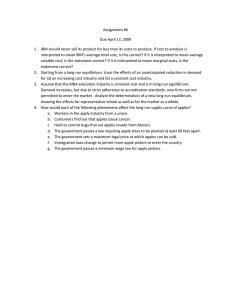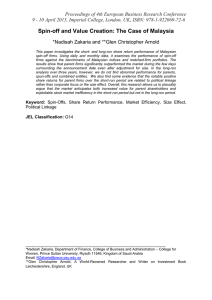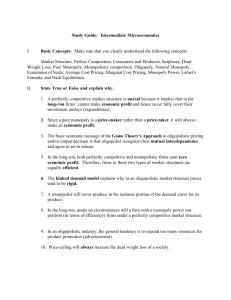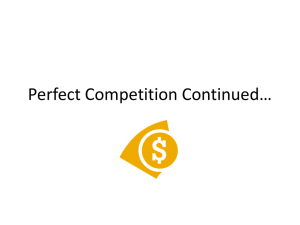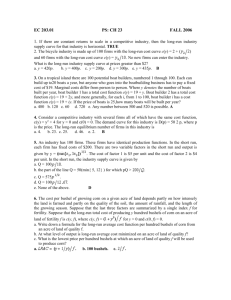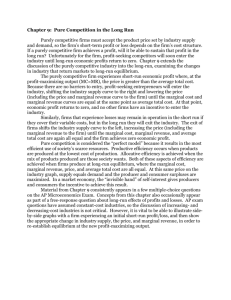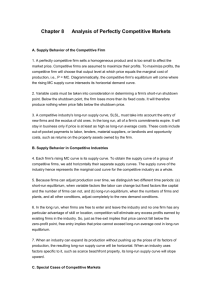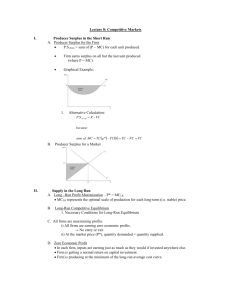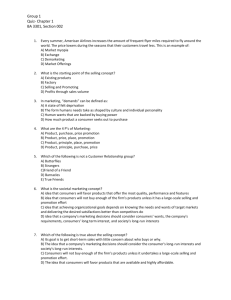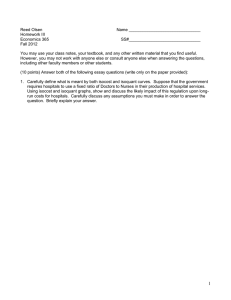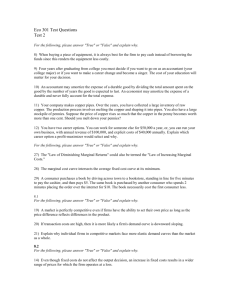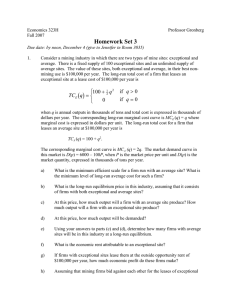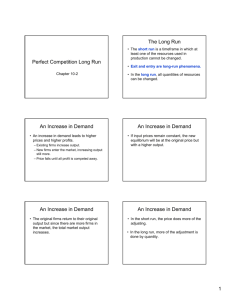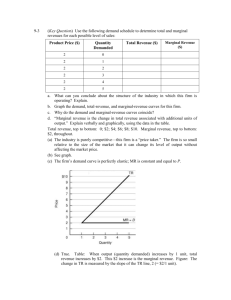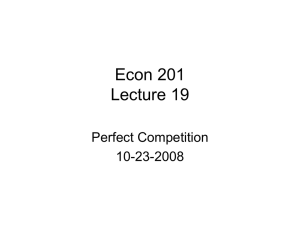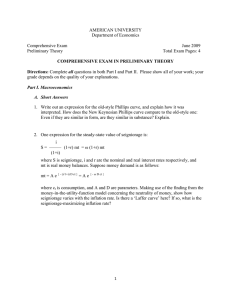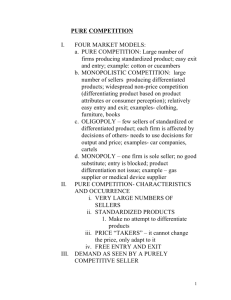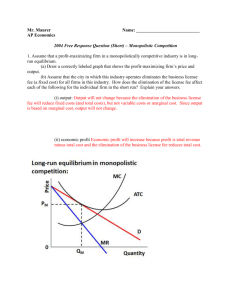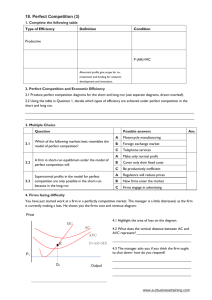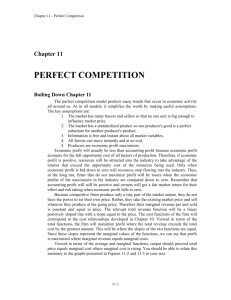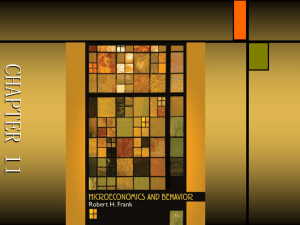Homework #5 Answers
advertisement
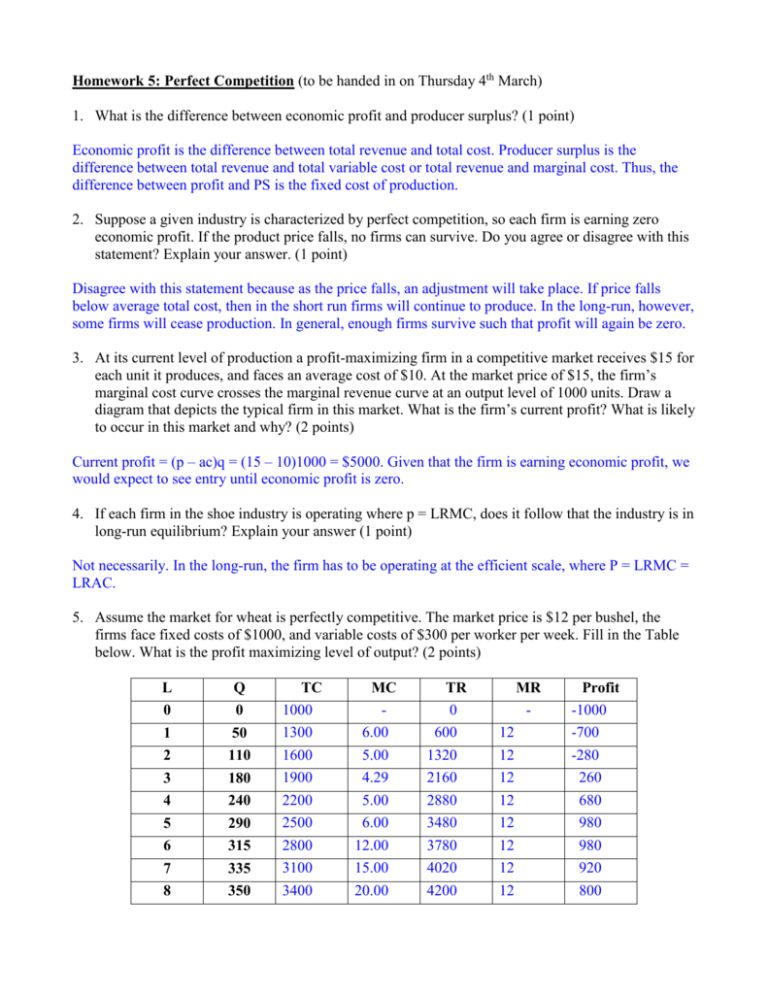
Homework 5: Perfect Competition (to be handed in on Thursday 4th March) 1. What is the difference between economic profit and producer surplus? (1 point) Economic profit is the difference between total revenue and total cost. Producer surplus is the difference between total revenue and total variable cost or total revenue and marginal cost. Thus, the difference between profit and PS is the fixed cost of production. 2. Suppose a given industry is characterized by perfect competition, so each firm is earning zero economic profit. If the product price falls, no firms can survive. Do you agree or disagree with this statement? Explain your answer. (1 point) Disagree with this statement because as the price falls, an adjustment will take place. If price falls below average total cost, then in the short run firms will continue to produce. In the long-run, however, some firms will cease production. In general, enough firms survive such that profit will again be zero. 3. At its current level of production a profit-maximizing firm in a competitive market receives $15 for each unit it produces, and faces an average cost of $10. At the market price of $15, the firm’s marginal cost curve crosses the marginal revenue curve at an output level of 1000 units. Draw a diagram that depicts the typical firm in this market. What is the firm’s current profit? What is likely to occur in this market and why? (2 points) Current profit = (p – ac)q = (15 – 10)1000 = $5000. Given that the firm is earning economic profit, we would expect to see entry until economic profit is zero. 4. If each firm in the shoe industry is operating where p = LRMC, does it follow that the industry is in long-run equilibrium? Explain your answer (1 point) Not necessarily. In the long-run, the firm has to be operating at the efficient scale, where P = LRMC = LRAC. 5. Assume the market for wheat is perfectly competitive. The market price is $12 per bushel, the firms face fixed costs of $1000, and variable costs of $300 per worker per week. Fill in the Table below. What is the profit maximizing level of output? (2 points) L 0 Q 0 1 2 3 4 5 6 7 8 50 110 180 240 290 315 335 350 TC 1000 1300 1600 1900 2200 2500 2800 3100 3400 MC 6.00 5.00 4.29 5.00 6.00 12.00 15.00 20.00 TR 0 600 1320 2160 2880 3480 3780 4020 4200 MR 12 12 12 12 12 12 12 12 Profit -1000 -700 -280 260 680 980 980 920 800 The profit maximizing level of output is where MR =MC, which is at 315 bushels of wheat per week. 6. Suppose that a competitive firm’s MC = 3 + 2q, AVC = 3 + q, and FC = 3. Assume that the market price is $9 per unit. (1.5 points) a) What level of output will the firm produce? b) What is the firm’s producer surplus? c) Will the firm be earning a positive, negative or zero profit in the short run? a) Set MR = MC. If 9 = 3 + 2q, then q = 3. b) PS = P – MC. Thus, PS = area of triangle above the supply curve and below the price. This is equal to 0.5(3)(6) = $9 c) Profit = TR – TC. TR = p*q = 9*3 = $27. TC = TFC + TVC = 3 + 3q + q2 = 3 + 9 + 9 = 21. Thus, economic profit = $6. (Note you could have also done it by knowing that PS = Economic profit = PS – fixed cost = 9 – 3 = $6). 7. How would each of the following affect the long-run supply of apples? (1.5 points) a) Hard-to-control bugs that eat apples invade from Canada b) Consumers find that apples cause cancer c) Immigration laws change to permit more itinerant apple pickers to enter the country a) The long-run supply will shift to the left (less supplied at every given price) b) No effect on supply or as demand shifts left, supply will shift left c) The long-run supply will shift to the right (input prices have gone down)
